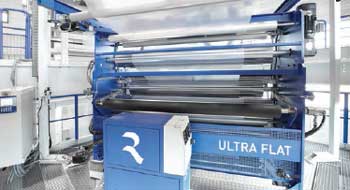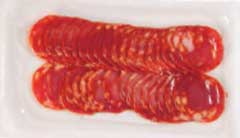Film/Sheet Extrusion Technology
Also, download this story from the electronic issue here
- German extrusion machinery maker Reifenhäuser Blown Film has sold five new extrusion lines to Asia in only six months, to Vietnam, Malaysia, South Korea and Philippines, integrated with the its patented Evolution Ultra Flat film flattening unit in the take-off. The company says it is an essential module used to enhance the quality and allows for an unproblematic conversion of the film, whether in laminating, printing, reforming, packaging or sealing operations. Surface irregularities are inherent to the blown film process. They can occur to a greater or lesser extent in the production of packaging film, depending on film dimensions and structures. The resulting waves can cause serious problems in winding and conversion. Reifenhäuser says with its Evolution Ultra Flat, a web of optimum flatness can be produced due to minimised stretching of the film via heating-cooling rolls - a prerequisite for winding and conversion on downstream equipment.
- The Asian market has responded to the newest Reifenhäuser technology with investments in the future. The first blown film line equipped with the Ultra Flat system came on stream in Vietnam about two years ago. The line configuration convinced both the owners and other interested customers outside Vietnam, with further orders that soon followed.

- Italian company Amut Group has recently boosted its presence in Asia with the establishment of new technical service points, offering complete onsite support. Furthermore, after the acquisition of Dolci & Bielloni company, Amut is able to offer a full range of services, from sorting to recycling, extrusion, thermoforming and printing equipment.
- Meanwhile, last year at the PlastMilan show, it exhibited a new stretch film cast line. This has led to a partnership with US-based Dow Chemicals and setting up a laboratory to test new configurations and recipes. Among the main innovations, the most significant one is the working speed: constant production up to 900 m/minute. The film thickness covers a range from 10-40 micron. The lines are based on a low energy consumption concept – savings of 0.4 kW/per kg – thanks to the watercooled motors of the extruders and the in-line scrap recovery system (savings up to 38%), in a cold process and without the re-granulation phase. The jumbo rolls, automatic and hand type, are slit in-line with perfect geometry, says the company. The cooling unit is equipped with a double cylinder of high diameter, especially designed for the production of “Super Power” stretch film. The compact line requires a space of 121 sq m, both for the 2 and 3-m versions.
- Austrian firm SML has developed and installed a new laminating line that is capable of downgauging the coating layer to a previously unobtainable extent using the so-called DoubleCoat process. The patent pending process has been integrated with SML’s FlexPack extrusion coating line, thereby enlarging the attainable range of breathable products.
- DoubleCoat combines extrusion coating with hot melt lamination and thus facilitates coating thickness minimisation. For example, a minimum coating layer thickness of 7 microns can be achieved using TPE on a PP nonwoven. This corresponds with roughly a quarter of the current average for such coatings and results in enormous material savings, says the firm, adding that quality is guaranteed and even with thin coating layers adhesion to the substrate is perfect, with no pinholes.
- Another exciting feature of the process is enhanced product breathability. The coating thickness has a significant effect on the water vapour transmission rate (WVTR), as a thinner layer results in a reduction in water vapour flow resistance. Consequently, standard product breathability can be increased several times over. A further advantage offered by the new process is a reduction in the melt temperature to a minimum. This has a very positive effect on the mechanical characteristics of the coating because the material is subject to less stress during extrusion, says SML.
- The DoubleCoat process provides fresh possibilities for enhanced product properties and lower production costs with regard to a variety of applications. These include medical products such as surgical drapes, which are highly breathable, flexible and serve as an effective barrier against viruses and bacteria. The process could also be used for protective clothing such as disposal overalls, or in view of its soft touch, stretchability and high breathability, for hygiene products. Moreover, traditional construction industry products, such as roofing underlay, can benefit from this new method. The firm has a production scale pilot plant in Austria for customer trialling.

- To further accelerate the development of packaging innovation, Dow Chemical is collaborating with Italian coating, laminating and metallising machinery maker Nordmeccanica. Both companies see enormous potential to advance solutions for the flexible packaging industry by combining adhesive development with machine pioneering that target new technologies for faster commercialisation to market. New developments can be expected from the joint collaboration with Dow and Nordmeccanica through Dow’s Pack Studios in Mozzate, Italy.
- Customised to address the needs of Dow’s adhesives customers, the centre hosts an industry-scale Nordmeccanica Super Combi 3000 laminator line for customers to test and prototype. The collaboration agreement between Dow and Nordmeccanica will also enable similar capabilities at additional Pack Studios across the globe. The companies say they are working on joint projects to bring several new technologies to market in 2016.
- Canada-based Macro Engineering & Technology and its sister company MT have expanded their refurbishing capability in their headquarters in Toronto, in line with increasing requests for refurbishing customers’ existing equipment. The company says that if the equipment is worn, several things can happen: polymer degradation increases, polymer flow distribution worsens over time, and melt temperature gradient is also questionable. With retrofitting of dies and old screws, equipment performance improves again and also allows for productivity and product quality.
- The refurbishing process involves evaluating the existing dies to assess damages if any, strip the plating, remachining the die surfaces if required, polishing and re-plating again. The dies are as good as new after finishing, says Macro. All the cleaning processes are done manually to ensure that the die is not overheated unnecessarily to prevent metal warpage, or cracking of the plating.
- Having recently installed a coextrusion die system from Nordson Corporation, Evertis de México, a processor specialising in PET-based semi-rigid packaging sheet, says it is able to maintain layer uniformity well within tolerances while avoiding product defects arising from barrier sheetasymmetrical layer structures, where materials or layer thicknesses above the central layer differ from those below it. It says Nordson EDI‘s system has made it possible to maintain tight layer tolerances in such structures while preventing “wave,” “zigzag” and other defects caused by instabilities at the interface between layers.
- Since critical layer interfaces are shifted into higher shear regions of the flow paths, coextrusion instabilities are more common with structures that are asymmetrical, says Nordson EDI, adding that its die system yields streamlined melt streams and finetunes them at the point of confluence.
- Evertis de México is part of the international IMG Group, a pioneer in the field of PET film extrusion. In addition to the plant in Mexico, the group has manufacturing facilities in Brazil and Portugal and sales offices throughout the Americas and Europe.

- At its open house that took place in Troisdorf- Bergheim at the end of last year, Polyrema, a Reifenhäuser company, showed a single-layer (mono) blown film line, extensively tested under production conditions on two days. On the first day, HDPE film was run while on the second day, a biodegradable film using resin from German chemicals maker BASF, was produced. It says that the ubiquitous HDPE films used as ultra-thin T-shirt carrier bags and for fresh produce are one of the reasons for the growing trend towards the new ecological films. Polyrema also demonstrated that the capabilities of mono-layer lines are far beyond this application. With an additionally installed Ultra Flat Plus unit, it says it is possible to produce a highquality film of slightly increased strength which can be laminated and coated, to produce, for example, the typical wrap film for butter packaging.
- A further highlight presented by Polyrema for the production of biofilm is a special screw cooling system installed in the Reifenhäuser extruder. Although it produces only mono-layer film, it is equipped with a two-layer blown film die head, with the melt divided in the blown film die in a 50:50 ratio and then combined again into two layers. As a result, the film structure is improved in terms of stability and strength, despite using only one raw material, says the firm.
Home | Terms & Conditions | Privacy Policy | Contact | Webmail | Site Map
Copyright (c) 2016 www.plasticsandrubberasia.com. All rights reserved.








































